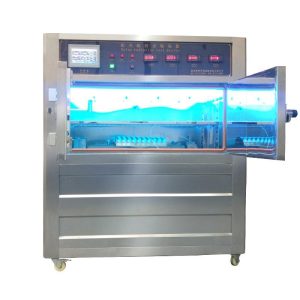การใช้ห้องทดสอบอายุของหลอด UV ในชิ้นส่วนอิเล็กทรอนิกส์
วัตถุประสงค์หลักของการทดสอบการเสื่อมสภาพด้วยรังสียูวีของชิ้นส่วนอิเล็กทรอนิกส์คือเพื่อประเมินความต้านทานต่อสภาพอากาศ, reliability and performance stability to determine their service life and performance performance in outdoor or exposed environments. Uv aging tests can simulate UV radiation in sunlight, as well as other environmental factors on electronic components.
Assess weather resistance: Electronic components are often exposed to outdoor environments and are affected by factors such as UV rays, การเปลี่ยนแปลงอุณหภูมิ, ความชื้น, และสารเคมีในชั้นบรรยากาศ. Uv aging tests can simulate these factors to evaluate the weatherability of electronic components under actual conditions of use.
Assessing reliability: The reliability of an electronic component refers to its ability to maintain the desired performance under specific environmental conditions. ผ่านการทดสอบความชราด้วยรังสียูวี, the stability and reliability of electronic components can be evaluated to know whether their performance degradation, ความเสียหายหรือความล้มเหลวจะเกิดขึ้นในการใช้งานระยะยาว.
ประเมินความเสถียรของประสิทธิภาพ: UV radiation can have adverse effects on the materials and structures of electronic components, such as material aging, สีซีดจาง, and changes in electrical properties. Through UV aging tests, the performance stability of electronic components under UV radiation can be evaluated to determine that they can maintain the desired performance during their service life.
การใช้ห้องทดสอบอายุของหลอด UV ในชิ้นส่วนอิเล็กทรอนิกส์
Guide product improvement and development: Through the results of UV aging tests, it is possible to understand the performance changes of electronic components under UV radiation, so as to guide the improvement and development of products and improve their weather resistance and reliability.
Through UV aging tests, important information about the weather resistance, ความน่าเชื่อถือ, and performance stability of electronic components in exposed environments can be provided. This helps manufacturers design and produce electronic products that are more durable and reliable, and ensure that they can work safely and reliably in a variety of environmental conditions.

การใช้ห้องทดสอบอายุของหลอด UV ในชิ้นส่วนอิเล็กทรอนิกส์
มาตรฐานอุตสาหกรรม
The UV aging test of electronic components usually requires reference to the following industry standards:
ไออีซี 60068-2-5: International Electrotechnical Commission (ไออีซี) standard for heat and hygrothermal testing of electronic equipment. ส่วนหนึ่ง 5 of these involves UV radiation tests under solar radiation.
ASTM G154: American Society for Materials and Testing (มาตรฐาน ASTM) standard for UV Radiation Testing of Nonmetallic Materials. It is suitable for evaluating the weather resistance and performance stability of materials.
JIS C 60068-2-5: Japanese Industrial Standard for heat and damp heat resistance tests of electronic equipment. อะไหล่ 2-5 of these relate to UV radiation tests under solar radiation.
MIL-STD-810: A US military standard covering the methods and requirements for testing electronic equipment under a variety of environmental conditions, including testing for ultraviolet radiation.
กิกะไบต์/ที 2423.24: Chinese national standard for environmental test methods for electrical and electronic products. ส่วนหนึ่ง 24 of these involves UV radiation tests.
การใช้ห้องทดสอบอายุของหลอด UV ในชิ้นส่วนอิเล็กทรอนิกส์
These standards provide guidance and specifications for UV aging tests, รวมถึงข้อกำหนดสำหรับอุปกรณ์ทดสอบ, วิธีทดสอบ, เงื่อนไขการทดสอบและระยะเวลา. ขึ้นอยู่กับการใช้งานและข้อกำหนดเฉพาะ, มาตรฐานอุตสาหกรรมเฉพาะอื่นๆ หรือข้อกำหนดภายในของบริษัทสามารถอ้างอิงถึงได้.
กรณีการสมัคร
The following are some specific application cases of UV aging test for electronic components:
LED components: UV aging tests are performed on leds (light emitting diodes) and related components to evaluate their stability, brightness attenuation, and color change in outdoor environments.
Solar cell modules: UV aging tests were performed on solar cell modules to evaluate their performance stability and weather resistance under long-term exposure to solar radiation.
Plastic packaged elements: UV aging tests are performed on plastic packaged elements used in electronic devices to evaluate their weather resistance, color stability, and mechanical strength under UV radiation.
Printed circuit Board (พีซีบี) : UV aging tests are performed on PCBS and their circuit components to evaluate their weather resistance, electrical stability, and contact corrosion in outdoor or exposed environments.
Cables and connectors: UV aging tests are performed on cables and connectors to evaluate their weather resistance, stability of electrical performance, and connection reliability in outdoor environments.
These application cases are only a part of the UV aging test of electronic components, and the practical application can be more customized and expanded according to different electronic devices and specific requirements. Uv aging tests help to evaluate the weather resistance and reliability of electronic components in exposed environments, providing important performance information to guide product improvement and development to ensure that electronic devices can work safely and reliably under various environmental conditions.
การใช้ห้องทดสอบอายุของหลอด UV ในชิ้นส่วนอิเล็กทรอนิกส์
Method of operation
The following are the steps and precautions for testing the aging resistance of electronic components using UV aging test chamber in general:
การจัดเตรียมตัวอย่าง: According to standards or requirements, select appropriate size samples of electronic components for testing. Ensure samples comply with relevant specifications and requirements.
การตั้งค่าเงื่อนไขการทดสอบ: ตามเงื่อนไขการทดสอบที่จำเป็นและข้อกำหนดมาตรฐาน, ตั้งค่าพารามิเตอร์ของห้องทดสอบอายุรังสียูวี, รวมถึงความเข้มของรังสีด้วย, อุณหภูมิ, ความชื้น, ฯลฯ. Be careful to set correctly according to standards or requirements.
ตำแหน่งตัวอย่าง: Place the electronic component samples on the sample rack inside the test chamber to ensure that the samples are in the right position and to avoid mutual interference between the samples.
ทดสอบการทำงาน: Start the UV aging test chamber and expose the sample to UV radiation under the set conditions. ตามข้อกำหนดมาตรฐาน, ตั้งเวลาทดสอบที่เหมาะสม, โดยปกติแล้วจะใช้เวลาหลายร้อยถึงหลายพันชั่วโมง.
การสังเกตอย่างสม่ำเสมอ: Regularly observe the changes of the sample, including appearance, สี, ขนาด, electrical properties, ฯลฯ. บันทึกการเปลี่ยนแปลงหรือความเสียหายที่มองเห็นได้.
สิ้นสุดการทดสอบและประเมินผล: เมื่อเสร็จสิ้นการทดสอบ, นำตัวอย่างออกเพื่อประเมินและทดสอบ. The physical and electrical properties of electronic components can be tested to determine their aging resistance.
การใช้ห้องทดสอบอายุของหลอด UV ในชิ้นส่วนอิเล็กทรอนิกส์
เมื่อทำการทดสอบการเสื่อมสภาพของรังสียูวี, ควรสังเกตเรื่องต่อไปนี้ด้วย:
ตรวจสอบให้แน่ใจว่าอุปกรณ์ของห้องทดสอบอายุ UV ทำงานอย่างถูกต้อง, และดำเนินการตามคู่มือการใช้งานและข้อกำหนดด้านความปลอดภัย.
ตรวจสอบและบันทึกอุณหภูมิ, ความชื้น, ความเข้มของรังสีและพารามิเตอร์อื่น ๆ ของห้องทดสอบเพื่อให้มั่นใจในความเสถียรและความแม่นยำ.
ตรวจสอบให้แน่ใจว่าได้เลือกตัวอย่าง, การจัดเตรียมและการจัดวางให้เป็นไปตามมาตรฐานและข้อกำหนด.
ตรวจสอบและบำรุงรักษาอุปกรณ์ห้องทดสอบอย่างสม่ำเสมอเพื่อให้มั่นใจว่าอุปกรณ์ทำงานตามปกติและถูกต้องแม่นยำ.
สังเกตและบันทึกการเปลี่ยนแปลงใดๆ ในกลุ่มตัวอย่างระหว่างการทดสอบเพื่อการประเมินและการวิเคราะห์ในภายหลัง.
Please note that the exact test methods and operating procedures may vary according to the standards and specific test requirements, so read the relevant standards carefully and follow the correct test procedures before performing UV aging tests.
